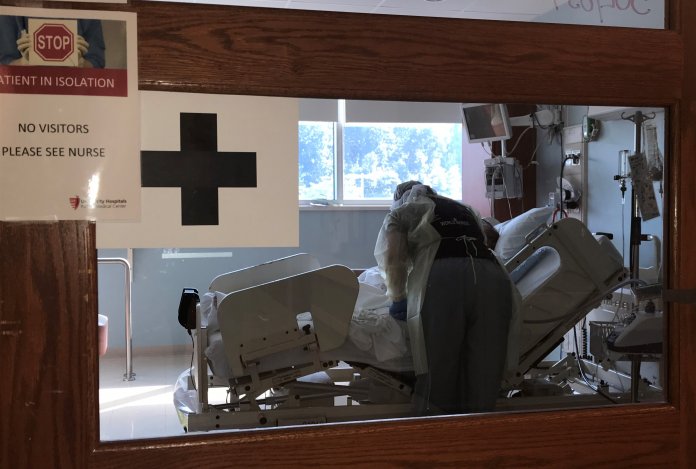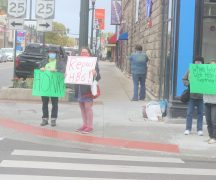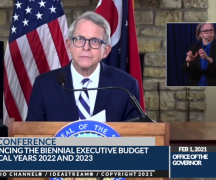Ohio Capital Journal
One in 10 Ohio nursing homes told regulators they didn’t have any N95 respirators on hand, which medical staff use to shield themselves from the coronavirus while treating infected patients.
Even among those that do, the supply chain is tenuous: 1 in 4 said they don’t have a week’s worth of the masks in store.
More than 20% of long term care facilities homes reported a nurse shortage as well, according to an analysis of the most recent nursing home survey from the Centers for Medicare and Medicaid Services from the end of July.
“They’re scared, and they’re worried that they’re transferring [the coronavirus] back to their homes,” said Josh Norris, executive vice president of SEIU 1199, a union whose members include nursing home workers.
“They don’t have enough protective equipment, they don’t believe they’re being protected, let alone the people they take care of.”
Nearly 2,500 nursing home residents have died of COVID-19 since the pandemic began according to Ohio Department of Health data released Wednesday, 67% of Ohio’s death toll. Sixty-eight residents died this week.
More than 5,200 staff members have been infected, including 489 in the last week. ODH does not publish a death count for staff. Nearly 10,000 nursing home residents have been infected, including 803 this week.
Infection control is a perennial problem for the nursing home industry. The CDC estimates between 1 and 3 million serious infections occur annually in long term care facilities.
The Ohio Capital Journal reported last month at least 35 nursing homes failed infection control audits tailored specifically around COVID-19. Some of those homes had a history of infection control citations as well.
It’s easy to forget, Norris said, that these nurses are humans caring for residents they may have known for years. Amid a gear shortage, they’re erring on the side of compassion over caution.
“They have to work — cloth masks, face coverings face shields, whatever they can use,” he said. “It’s sickening the way they’re being treated and not being provided what they need to keep themselves safe.
Pete Van Runkle, executive director of Ohio Health Care Association, which represents long term care facilities, said the facilities that don’t have N95s “generally” are using KN95s (which were temporarily approved for use by the FDA in April).
“The [personal protective equipment] shortages actually have improved considerably from earlier in the pandemic, but staffing is becoming a greater challenge as the pandemic wears on and schools are reopening in parts of the state,” he said in an email.
The CMS survey data, analyzed by the Ohio Capital Journal, shows most nursing homes currently have other PPE including gloves, gowns, eye protection and surgical masks.
However, a missing shipment could deplete many facilities of their gear. They said they lack a one-week supply of N95s (23%), gowns (13%), surgical masks (8%), eye protection (7%), and gloves (5%).
The new coronavirus poses a deadly threat if it enters senior care centers, an ominous fact given the more than 1,100 new cases in Ohio reported daily, per a seven-day moving average.
Findings from the CDC published Tuesday crystalizes the threat: researchers documented mass testing at several nursing homes, finding that every day between nursing home staff identifying a case and completing facility-wide testing was associated with 1.3 additional cases.
“Performing facility-wide testing rapidly following identification of a case in a nursing home might facilitate control of transmission among residents and health care personnel,” the CDC found.
***
Child health in Ohio impacted by food insecurity, racial disparities, broadband access. Pandemic impact still unknown.
Infant mortality, broadband connectivity, and racial disparities have been named as major impacts on child health and success, especially as the pandemic continues to create uncertainty educationally and economically throughout the state.
A state child advocacy group released its analysis of child welfare before the pandemic, and said the data should be a guide for county and state officials as education, health care and the economy struggle for recovery.
The Children’s Defense Fund Ohio showed a cross-section of the impacts in their annual county-by-county profile of indicators that measure child success, including access to safe and stable homes, and the household ability to pay for utilities like electricity and internet access. READ MORE
Trying to avoid the fray, DeWine pleads for federal help for cities and states
Ohio Gov. Mike DeWine on Thursday tried to stay out of Washington’s political battles while making an impassioned plea for federal assistance to state and local governments.
Negotiations over a coronavirus-relief bill have been stalemated since last month, when a $600-a-week federal supplement to unemployment checks expired. While the Democratically controlled House passed a $3 trillion relief bill May 15, Senate Majority Leader Mitch McConnell, R-Kentucky, didn’t propose a $1 trillion alternative until late July — even then conceding that he likely didn’t have the votes to pass it.
That left congressional Democrats negotiating with the White House. A major sticking point between them is a Democratic demand for more than $900 billion in assistance to state and local governments whose revenues have plummeted as COVID-19 has suffocated economic activity. READ MORE





